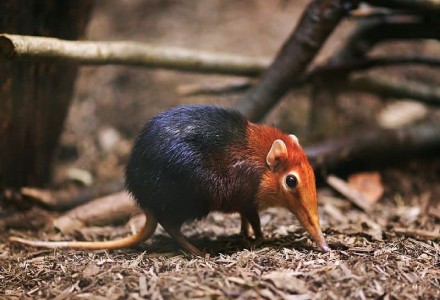
Elephant Shrew Facts
- Not surprisingly, the Elephant Shrew tops many lists of remarkable small mammals. This status exists because it has several attributes normally associated with other animals.
- However, several species of this amazing small animal exist. Furthermore, all of them have prehensile snouts, the same as an elephant. This, therefore, serves as the source of the common name.
- Further, the IUCN currently lists two of those species as either Vulnerable or Endangered. But, the other forms of the creature may soon hold the same status. This holds true due to declining populations.
- This animal can move extremely rapidly and agilely for a small mammal. In fact, it ranks as one of the fastest of all small mammals. Catching it is (fortunately) therefore extremely difficult.
- The long legs of this shrew provide it with a distinctive means of locomotion. Not only does it display great speed and agility, it can hop like a rabbit, making it highly elusive.
Related Species
Bandicoot Lowland Streaked Tenrec Southern Tamandua
Elephant Shrew Physical Description
The Elephant Shrew has a rather small form, similar in size to its namesake shrews. This animal attains an average body length of 11.8 in (30 cm), and a weight of as much as 1.1 lb (0.5 kg).
The long tail remains hairless. Elephant Shrews also possess long legs, relative to body size. Its trunk ranks as one of its most noteworthy features and evolved to be prehensile.
Coloring varies greatly among individuals, yet mixtures of red and brown predominate. Individuals also have a highly elongated tongue which is used to feed on prey, like an anteater.
Unlike many related species, this mammal does not display any noticeable degree of sexual dimorphism. Finally, despite its diet, it has rather enlarged canine teeth for a shrew.
- Kingdom: Animalia
- Phylum: Chordata
- Class: Mammalia
- Order: Macroscelidia
- Family: Macroscelididae
Elephant Shrew Distribution, Habitat, and Ecology
The Elephant Shrew evolved on the continent of Africa. Additionally, the various species inhabit different habitats. Most prefer jungle regions, while a few actually inhabit regions of the desert.
Being primarily insectivorous, it consumes a variety of invertebrates including insects and earthworms. Yet individuals will occasionally consume fruits and seeds to supplement the usual diet.
While this shrew occasionally lives in pairs, it typically remains non-social creatures. As a result, even mated pairs often maintain separate nests. These commonly have been constructed in rock crevices, or with leaves.
Further, its usual pattern of activity is also primarily diurnal. The impressive small the animal also remains highly active. Finally, the mammal also typically lives for 3-4 years in the wild.
Species Sharing Its Range
Cheetah African Blackwood Scorpionfly
Check out our other articles on Coudersport Ice Mine, Vietnamese Mossy Frog, Rose of Jericho, Giant Manta Ray, 6 Magnificent Carnivorous Plants, Indian Giant Squirrel

